Featured
Shroud of the Avatar
Brittany Sewers, Boss Fight
Released July 28, 2016
An evil ritual in the heart of the Brittany Sewers. Click for a larger image.
A great evil lurks deep in the heart of the Brittany Sewers. Exploring deep into this massive underground scene reveals greater and greater challenge, culminating in a unique boss fight.
Dropping into boss fight room, the first thing players see are several shadowy figures performing a ritual, complete with candles and corpse. Next, they might realize the only way out is a locked door on the far side. They've entered a "kill or be killed" situation with no options in-between.
Approaching the ritualists starts the fight scenario--the entry is blocked (no reinforcements allowed!) and the enemies begin fighting. When the ritualists are defeated, another, greater threat appears out of the sewer water: animated skeletons. Defeating the skeletons catches the attention of their three masters, the ultimate bosses of the room.
Dying at any point resets the boss fight scenario, but defeating all enemies opens up the locked door mentioned above. Past the door is a tunnel that leads to a treasure room and an exit back to the main tunnels of the sewer.
Keith designed the boss fight, room and its new combat system which is used to manage waves of enemies and the rewards following the defeat of each wave (for example, unlocking a door).
Tags: multiplayer, Portalarium, single-player
Brittany Sewers, Dockside
Released June 30, 2016
Entering Brittany Sewers from Central Brittany puts you here. Click for a larger image.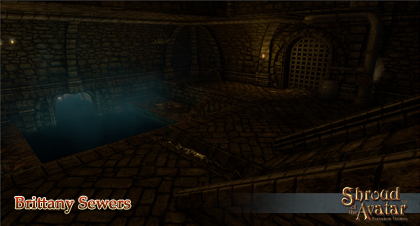
Entering the sewers from Brittany Alleys puts you here. Click for a larger image.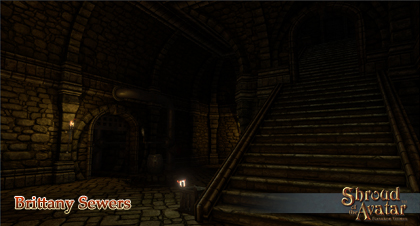
A flooded room includes a subtle jumping puzzle. Click for a larger image.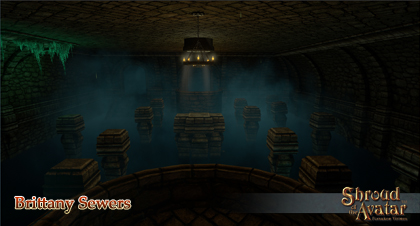
Smugglers gather between the "Central" and "Alleys" exits. Click for a larger image.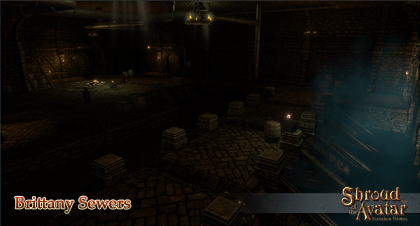
A steam-based puzzle controls access to the sewer center. Click for a larger image.
The capital city of Brittany in Shroud of the Avatar was conceived as a single scene but became several neighborhoods by the time it went live, each with its own separate scene and personality. Underneath the city is Brittany Sewers, an exploration area that needed to reflect the massive scope of the city above.
Several times larger than nearly every other underground scene in SotA, these sewers will ultimately connect to each Brittany neighborhood. Connections are set up in pairs: the "dockside" tunnels connect to Central Brittany and Brittany Alleys, the "catacombs" section will link to Brittany Graveyard and Brittany Wharfs, and the "caverns" section will exits to Brittany Estates and Brittany Fields.
Each section has its own personality, enemies, unique puzzle, and connection to all other sections. The sewers grows more dangerous as one journeys toward its center, culminating in a special, high-threat boss fight.
Keith created the overall concept of the sewers, the dockside section, and the catacombs' graveyard entrance. The dockside embraces the concept that smugglers from the faraway Hidden Vale are committing crimes in the maintenance tunnels right under the noses of New Britannia's rules.
The doors throughout the dockside section are steam-powered, each opened by the turn of a wheel on a steam pipe. These steam-powered doors are a precursor to the more complex steam-powered puzzle that blocks access from the dockside section to the center of the Brittany Sewers.
Tags: multiplayer, Portalarium, single-player
Balloons as Teleporters
Released May 26, 2016
Several examples of teleporter balloons. Click for a larger image.
The world of Shroud of the Avatar is divided into many adventure, town, and story scenes. Exiting a scene can be as simple as walking to the edge of the play area, but SotA also includes many interactive teleporters. The visuals for these teleporters are important. If a player is fictionally traveling along a dusty road then the interactive teleporter is probably a caravan wagon. If a player is being sent across an ocean, then a teleporter that looks like a ship is called for. Going underground is accomplished by clicking on a hatch. But SotA didn't have the perfect teleporter for all situations, such as when a player wanted to travel from an island to a land-locked mountain.
Keith conceived of the teleporter balloon. Based off existing house-sized dirigibles used in the game, these new balloons were smaller with one-occupant baskets. He added two scripts to perfect the balloon visual: one to make the balloon float and another to dynamically spin the balloon depending on the direction of the wind in the scene.
Tags: multiplayer, Portalarium, single-player
Control Point Perks
Released April 28, 2016
In Shroud of the Avatar, Control Points mark contested locations where players are pitted against waves of non-player enemies. Each wave of enemies is more powerful than the last, and waves come with ever-increasing frequency. It's a high-level activity intended for a seasoned group, although these locations also draw highly-skilled players who enjoy taking one-person "endurance tests."
When Keith inherited this system, he noted that surviving against difficult enemies is satisfying, while defending a Control Point against waves and waves of enemies was a monumental achievement that deserved additional rewards. Working with the programming team, he added "perks" to this system. Perks would be activated during certain waves and would include access to locked rooms that included special treasure chests. Where once surviving against the Control Point waves meant bragging rights and normal loot, now it also meant access to better and better treasure perks. Perks allowed Control Points to become more solidified as a true end-game option in SotA.
Tags: multiplayer, Portalarium, single-player
Underground Passages
Released April 28, 2016
A view of the Spindrift Passage scene. Click for a larger image.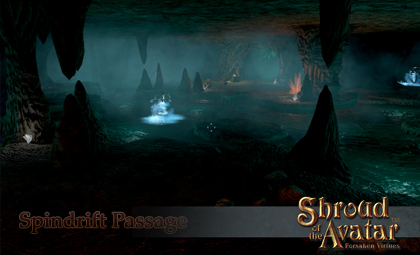
A view of the Paladis Passage scene. Click for a larger image.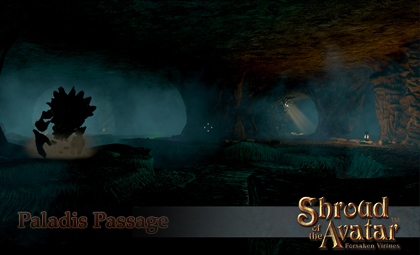
The Shroud of the Avatar team wanted to interconnect all of its underground scenes in a vast network. A few of SotA's dungeons, sewers, and mines were already interconnected, but a primary goal was to allow players to cross the continent of Novia entirely through underground scenes.
Keith divided existing underground scenes into small, natural groups or "sectors." The enemies and harvestable resources in each scene were updated to better reflect the distributions on the surface world. He created several new underground scenes (such as Brittany Sewers) to add more substance to each sector. Players may freely travel across scenes linked within a sector.
Then, Keith created special passages to connect each underground sector to at least one other sector. Each passage was locked to keep the rate of underground travel on par with overworld travel. Players could only access a locked passages by first defeating a rare key-bearer in a free-travel scene and looting his key, then using that key to access the nearby passage to the next sector.
Each locked passage is moderately-sized and designed to fit within the fiction of its part of the world. Because Spindrift Passage lies under the large Spindrift Bay, its dripping caverns are full of deep, swimmable water, harvestable resources related to its connecting points, and water elemental enemies. Underneath a monumental lava-filled rift lies Quel Passage, with its blackened tubes, pools of lava, and fire elementals.
Tags: multiplayer, Portalarium, single-player
Tier Markers
Released September 24, 2015
Examples of Tier Markers in several scenes. Click for a larger image.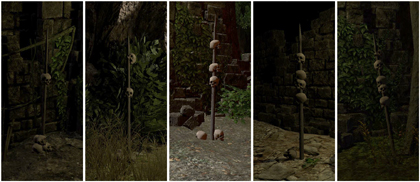
Players should have indications that they scenes they're adventuring within are appropriate for their abilities and experience. Many games display the power-level of enemies with a combination of level numbers, icons, and colors. However, Shroud of the Avatar downplays UI indicators and focuses instead on experiences. In other words, players should learn how difficult an enemy is through personal experience and not from a display.
Embracing SotA's experience-based philosophy, Keith created "tier marker" scene decorations. He added a tall spike and five skulls by the entrance of every adventure scene as an in-character solution that hints at the challenge level of each scene. Players could get an understanding of the difficulty of nearby enemies by referring to the tier markers; the more skulls on the spike, the more challenging the enemies. For example, one skull on the spike and four remaining on the ground suggested the area was fairly easy, while all 5 skulls moved to the spike meant it was one of the most dangerous.
Tags: multiplayer, Portalarium, single-player

